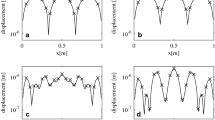Abstract
In this study, estimation of some physical properties of a laminated composite plate was conducted via the inverse vibration problem. Laminated composite plate was modelled and simulated to obtain vibration responses for different length-to-thickness ratio in ANSYS. Furthermore, a numerical finite element model was developed for the laminated composite utilizing the Kirchhoff plate theory and programmed in MATLAB for simulations. Optimizing the difference between these two vibration responses, inverse vibration problem was solved to obtain some of the physical properties of the laminated composite using genetic algorithms. The estimated parameters are compared with the theoretical results, and a very good correspondence was observed.
Similar content being viewed by others
References
C. H. Huang, A nonlinear inverse problem in estimating simultaneously the external forces for a vibration system with displacement-dependent parameters, Journal of the Franklin Institute, 342 (7) (2005) 793–813.
E. H. Shiguemori, L. D. Chiwiacowsky, H. F. de Campos Velho and J. D. S. Da Silva, An inverse vibration problem solved by an artificial neural network, Trends in Applied and Computational Mathematics, 6 (1) (2005) 163–175.
L. D. Chiwiacowsky, H. F. Campos Velho and P. Gasbarri, A variational approach for solving an inverse vibration problem, Inverse Problems, Design and Optimization Symposium, Rio de Janerio, Brazil (2004).
G. M. L. Gladwell, Inverse vibration problems for finiteelement models, Inverse Problems, 13 (2) (1997) 311.
C. C. Kang and C. Y. Lo, An inverse vibration analysis of a tower subjected to wind drags on a shaking ground, Applied Mathematical Modelling, 26 (4) (2002) 517–528.
S. Homolya, I. D. Svalbe and C. F. Osborne, Numerical determination of the density profile of an inhomogeneous membrane: Solution of the inverse vibration problem, Journal of Sound and Vibration, 261 (2) (2003) 193–211.
M. Cetkovic and D. Vuksanovic, Bending, free vibrations and buckling of laminated composite and sandwich plates using a layerwise displacement model, Composite Structures, 88 (2) (2009) 219–227.
P. Subramanian, Dynamic analysis of laminated composite beams using higher order theories and finite elements, Composite Structures, 73 (3) (2006) 342–353.
L. Jun, H. Hongxing and S. Rongying, Dynamic finite element method for generally laminated composite beams, International Journal of Mechanical Science, 50 (2008) 466–480.
G. S. Ramtekkar, Y. M. Desai and A. H. Shah, Natural vibrations of laminated composite beams by using mixed finite element modelling, Journal of Sound and Vibration, 257 (4) (2002) 635–651.
G. L. C. M. De Abreu, J. F. Ribeiro and V. Steffen, Finite element modeling of a plate with localized piezoelectric sensors and actuators, Journal of the Brazilian Society of Mechanical Sciences and Engineering, 26 (2) (2004) 117–128.
J. De Visscher, H. Sol, W. P. De Wilde and J. Vantomme, Identification of the damping properties of orthotropic composite materials using a mixed numerical experimental method, Applied Composite Materials, 4 (1) (1997) 13–33.
J. Cugnoni, T. Gmür and A. Schorderet, Inverse method based on modal analysis for characterizing the constitutive properties of thick composite plates, Computers & Structures, 85 (17) (2007) 1310–1320.
A. L. Araujo, C. M. Soares, J. Herskovits and P. Pedersen, Estimation of piezoelastic and viscoelastic properties in laminated structures, Composite Structures, 87 (2) (2009) 168–174.
M. Matter, T. Gmür, J. Cugnoni and A. Schorderet, Numerical-experimental identification of the elastic and damping properties in composite plates, Composite Structures, 90 (2) (2009) 180–187.
N. Khaji and M. Mehrjoo, Crack detection in a beam with an arbitrary number of transverse cracks using genetic algorithms, Journal of Mechanical Science and Technology, 28 (3) (2014) 823–836.
A. Batish, A. Bhattacharya, M. Kaur and M. S. Cheema, Hard turning: Parametric optimization using genetic algorithm for rough/finish machining and study of surface morphology, Journal of Mechanical Science and Technology, 28 (5) (2014) 1629–1640.
J. N. Reddy, Mechanics of laminated composite plates and shells theory and analysis, CRC Press, New York (1997).
L. P. Kollár and G. S. Springer, Mechanics of Composite Structures, Cambridge University Press, New York (2003).
M. Petyt, Introduction to finite element vibration analysis, Cambridge University Press, New York (2010).
M. Balci, Estimation of physical properties of laminated composites via the method of inverse vibration problem, Ph.D. Thesis, Graduate School of Natural and Applied Sciences, Ataturk University, Turkey (2011).
Author information
Authors and Affiliations
Corresponding author
Additional information
Recommended by Editor Yeon June Kang
Murat Balci is an Assistant Professor, Department of Mechanical Engineering, Bayburt University, Turkey. He received his Ph.D. degree from Ataturk University in Turkey in 2011. He has been mainly engaged in the research of structural vibration and vibration control.
Omer Gundogdu is a Professor, Department of Mechanical Engineering, Ataturk University, Turkey. He received his Ph.D. degree from Rensselaer Polytechnic Institute in USA in 2000. He has been mainly engaged in the research of structural vibration and biomechanics.
Rights and permissions
About this article
Cite this article
Balci, M., Gundogdu, O. Estimation of physical properties of laminated composites via the method of inverse vibration problem. J Mech Sci Technol 31, 29–36 (2017). https://doi.org/10.1007/s12206-016-1204-4
Received:
Revised:
Accepted:
Published:
Issue Date:
DOI: https://doi.org/10.1007/s12206-016-1204-4




